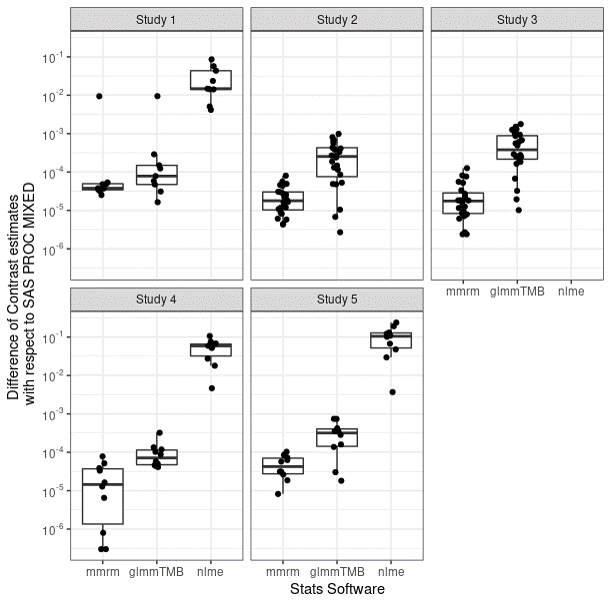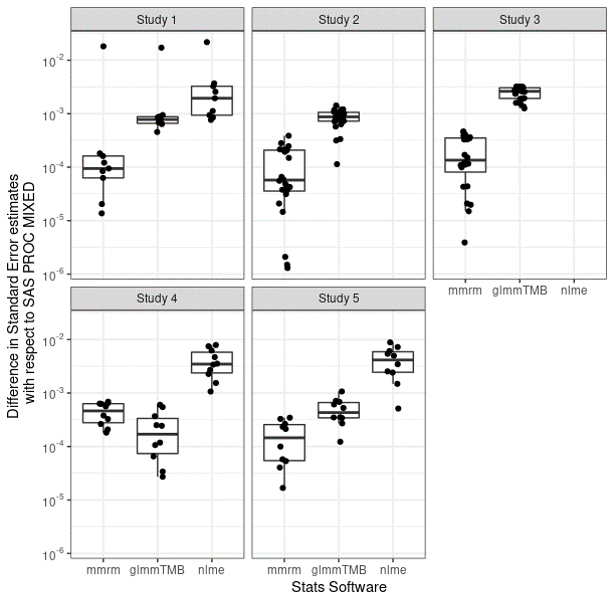Plugging the gaps: Lessons learned from implementing the mmrm R package
Kevin Kunzmann on behalf of the ASA BIOP SWE WG
Boehringer Ingelheim
June 13, 2023
Package Authors:
- Brian Matthew Lang (MSD)
- Christian Stock (Boehringer-Ingelheim)
- Craig Gower-Page (Roche)
- Dan James (AstraZeneca)
- Daniel Sabanes Bove (Roche, lead)
- Doug Kelkhoff (Roche)
- Julia Dedic (Roche)
- Kevin Kunzmann (Boehringer-Ingelheim)
- Liming Li (Roche)
- Ya Wang (Gilead)
Acknowledgments & thanks to:
Ben Bolker (McMaster University), Davide Garolini (Roche), Dinakar Kulkarni (Roche), Gonzalo Duran Pacheco (Roche),
ASA BIOP Software Engineering working group (SWE WG)
Agenda
- Overview of Open Source in Biostatistics
- Case Study:
{mmrm}Package- Mixed Models for Repeated Measures - Why bother?
- Why this is not “yet another package”
- Lessons Learned
- Next Steps
Open Source in Biostatistics
- Open-source software increasing popularity in Biostatistics
- Rapid uptake of novel statistical methods
- Unprecedented opportunities for collaboration
- Transparency of methods and implementation
- Variability in software quality
- No statistical quality assurance on open-source extension package repositories, e.g. CRAN
- No industry standard for assessing quality of R packages
- Reliable software for core statistical analysis is paramount
The ASA BIOP SWE Working Group
- Idea: form industry working group to identify and fill gaps in R package landscape with reliable implementations of crucial methods
- ASA Biopharmaceutical section software engineering working group (ASA BIOP SWE WG)
- Foster good coding practices for easier maintenance, review. and transparency:
- Version control for traceability and structured change management
- Self-sufficient high-quality documentation
- Code style standards for easier review
- Extensive unit testing and CI/CD for test-driven development
- Reproducible outputs, especially for stochastic algorithms
Why do we need a package for MMRMs?
- MMRM popular for longitudinal continuous outcomes in randomized clinical trials
- Think about long term maintenance and responsibility!
- Try to improve existing package
- extend
glmmTMBwith Satterthwaite adjusted degrees of freedom - not feasible:
glmmTMBonly random effects representation, no real unstructured model
- extend
- No tailored R package with sufficient capabilities/reliability
lme4+lmerTest: fails on large data sets (slow, convergence issues)nlme: no Satterthwaite adjusted degrees of freedom, convergence issues, only approximateemmeans
Case Study: The {mmrm} Package
- Linear model for dependent observations within independent subjects
- Multiple covariance structures for the dependent observations
- REML or ML estimation, using multiple optimizers if needed
emmeansinterface for least square meanstidymodelsfor easy model fitting- Satterthwaite and Kenward-Roger adjustments for degrees of freedom
- Designed for needs of pharma applications from ground up
- Ongoing maintenance and support from the pharma industry
- 5 companies involved in the development
- ambition to become standard package within the field
How we develop {mmrm}
- Created initial prototype quickly, open-sourced on github.com/openpharma/mmrm
- In parallel, assembled multiple other companies with shared interest in reliable MMRM for R
- \(\leadsto\) Start of Software Engineering working group (SWE WG), with >35 members from >25 organizations
- Focus on core issues and aim for frequent releases of new features instead of waiting for perfect state
- Do not compromise quality on the way, rather less done well
- Regular online developer calls to align next steps
Getting started with {mmrm}
{mmrm}is on CRAN - use this as a starting point:
- Visit openpharma.github.io/mmrm for detailed docs
Comparing {mmrm} and SAS
Comparison to de-facto gold standard in SAS with PROC MIXED:
{mmrm}
- Documentation: Available online
- Testing: Transparent + coverage
- Covariance structures: 10 non-spatial covariance structures
- Focus on population marginal models
PROC MIXED
- Documentation: Available online
- Testing: Hidden
- Covariance structures: 23 non-spatial covariance structures
- Marginal and individual level random effects
Deviation from SAS
- negligible differences from SAS in (non-representative) set of examples
{mmrm}orders of magnitude closer than{glmmTMB}or{nlme}


Speed
{mmrm}fast due to C++ code via template model builder (TMB) library{mmrm}uses efficient automatic gradients for the ML/REML objective

Lessons Learned: Best Practices
- User interface design (function names etc.)
- Difficult to get right
- Spend enough time on making it convenient/familiar
- Testing:
- Unit tests are essential for preventing regression and assuring quality
- Use continuous integration to catch errors early
- Documentation:
- Lots of work but extremely important
- Needs to be kept up-to-date
- Testing alone is not sufficient - also use example & vignettes for building trust with users
Lessons Learned: Collaboration
- Important to go public as soon as possible - you never know who else might be interested/could help
- Version control with git: cornerstone of effective collaboration
- Agree on standards:
- Consistent and readable code style: transparency and easier collaboration
- How to contribute: Written (!) contribution guidelines + lowering the entry hurdle using developer calls
- Leverage network of developers in companies to get feedback from real projects as soon as possible
- Emphasize importance of non-coding contributions like documentation
Long Term Perspective & Next Steps
- Software engineering is a critical competence in producing high-quality statistical software
- A lot of work needs to be done regarding the establishment, dissemination and adoption of best practices for engineering open-source software
- Improving the way software engineering is done will help improve the efficiency, reliability and innovation within Biostatistics
- Continue to highlight and support cross-industry collaboration through, e.g.: Phuse, R Consortium, openpharma
- Publicize existing open source projects, e.g.:
admiral,rtables, Bayesianmmrm
Thank you! Questions?



